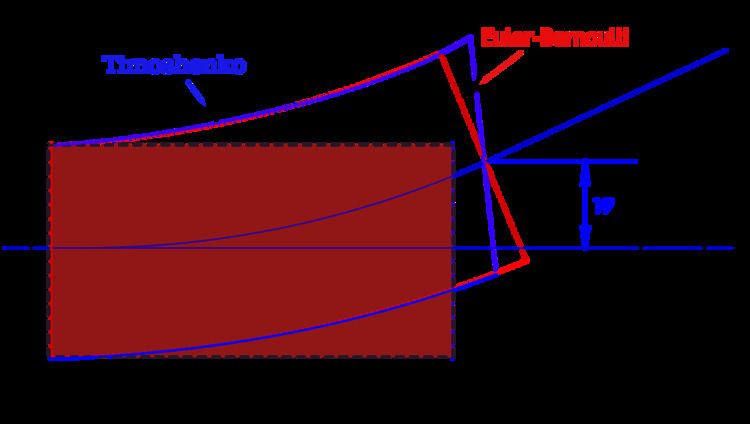 | ||
The Timoshenko beam theory was developed by Stephen Timoshenko early in the 20th century. The model takes into account shear deformation and rotational bending effects, making it suitable for describing the behaviour of short beams, sandwich composite beams, or beams subject to high-frequency excitation when the wavelength approaches the thickness of the beam. The resulting equation is of 4th order but, unlike ordinary Euler–Bernoulli beam theory, there is also a second-order partial derivative present. Physically, taking into account the added mechanisms of deformation effectively lowers the stiffness of the beam, while the result is a larger deflection under a static load and lower predicted eigenfrequencies for a given set of boundary conditions. The latter effect is more noticeable for higher frequencies as the wavelength becomes shorter, and thus the distance between opposing shear forces decreases.
Contents
- Quasistatic Timoshenko beam
- Boundary conditions
- Example Cantilever beam
- Dynamic Timoshenko beam
- Axial effects
- Damping
- Shear coefficient
- References
If the shear modulus of the beam material approaches infinity - and thus the beam becomes rigid in shear - and if rotational inertia effects are neglected, Timoshenko beam theory converges towards ordinary beam theory.
Quasistatic Timoshenko beam
In static Timoshenko beam theory without axial effects, the displacements of the beam are assumed to be given by
where
The governing equations are the following uncoupled system of ordinary differential equations:
The Timoshenko beam theory for the static case is equivalent to the Euler-Bernoulli theory when the last term above is neglected, an approximation that is valid when
where
Combining the two equations gives, for a homogeneous beam of constant cross-section,
The bending moment
Boundary conditions
The two equations that describe the deformation of a Timoshenko beam have to be augmented with boundary conditions if they are to be solved. Four boundary conditions are needed for the problem to be well-posed. Typical boundary conditions are:
Example: Cantilever beam
For a cantilever beam, one boundary is clamped while the other is free. Let us use a right handed coordinate system where the
Let us assume that the clamped end is at
and
Therefore, from the expressions for the bending moment and shear force, we have
Integration of the first equation, and application of the boundary condition
The second equation can then be written as
Integration and application of the boundary condition
The axial stress is given by
Dynamic Timoshenko beam
In Timoshenko beam theory without axial effects, the displacements of the beam are assumed to be given by
where
Starting from the above assumption, the Timoshenko beam theory, allowing for vibrations, may be described with the coupled linear partial differential equations:
where the dependent variables are
These parameters are not necessarily constants.
For a linear elastic, isotropic, homogeneous beam of constant cross-section these two equations can be combined to give
The Timoshenko equation predicts a critical frequency
Axial effects
If the displacements of the beam are given by
where
where
where
The combined beam equation with axial force effects included is
Damping
If, in addition to axial forces, we assume a damping force that is proportional to the velocity with the form
the coupled governing equations for a Timoshenko beam take the form
and the combined equation becomes
A caveat to this Ansatz damping force (resembling viscosity) is that, whereas viscosity leads to a frequency-dependent and amplitude-independent damping rate of beam oscillations, the empirically measured damping rates are frequency-insensitive, but depend on the amplitude of beam deflection.
Shear coefficient
Determining the shear coefficient is not straightforward (nor are the determined values widely accepted, i.e. there's more than one answer); generally it must satisfy:
The shear coefficient depends on the Poisson's ratio. The attempts to provide precise expressions were made by many scientists, including Stephen Timoshenko, Raymond D. Mindlin, G. R. Cowper, N. G. Stephen, J. R. Hutchinson etc. (see also the derivation of the Timoshenko beam theory as refined beam theory based on the variational-asymptotic method in the book by Khanh C. Le leading to the different shear coefficients in the static and dynamic cases). In engineering practice, the expressions by Stephen Timoshenko are sufficient in most cases. In 1975 Kaneko published an excellent review of studies of the shear coefficient. More recently new experimental data show that the shear coefficient is underestimated.
According to Cowper (1966) for solid rectangular cross-section,
and for solid circular cross-section,
